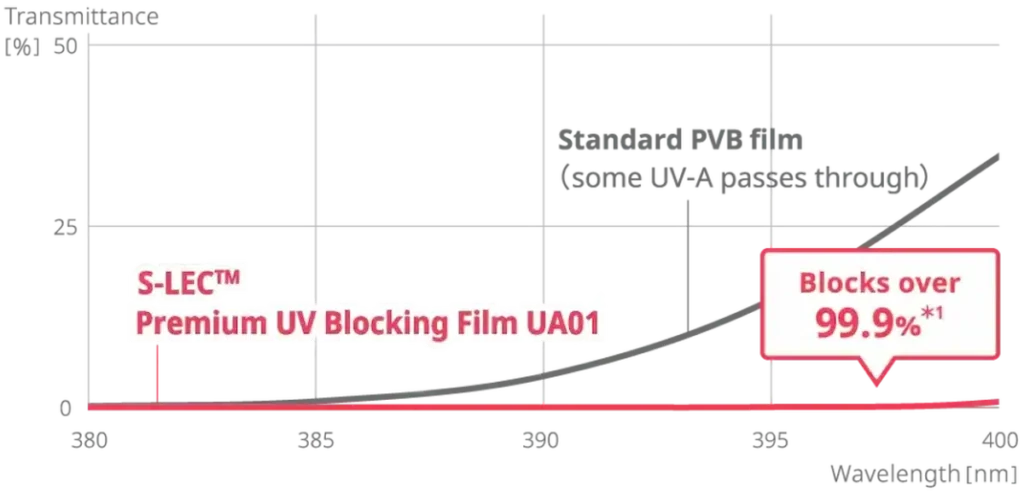
We receive a great amount of sunlight in our daily lives. On the other hand, overexposure to sunlight poses the risk of skin aging (photoaging) and skin cancer due to the effects of ultraviolet rays contained in sunlight.
Ultraviolet rays can be divided into three types according to their wavelengths: UV-A, UV-B, and UV-C. UV-C (200-280nm), the most harmful type of ultraviolet radiation, is mostly absorbed by the ozone layer and does not reach the surface of the earth; UV-B (280-315nm) reaches only the outer layer of the skin, but can cause dermatitis, freckles, and dry skin; UV-A (314-400nm) is hardly absorbed by the ozone layer and reaches the earth’s surface even on cloudy days. UV-A can penetrate into deeper layers of the skin (dermis) and can cause long-term skin damage to the human body. In addition, UV-A light can damage and age objects.

Laminated glass with a standard PVB interlayer film does not cut off all UV-A, allowing it to enter the interior of the vehicle.
S-LEC™ Premium UV Blocking Film UA01 has the world’s highest level of UV-A blocking performance as an interlayer film for automotive laminated glass, blocking more than 99.9%*1 of UV-A, preventing light radiation from entering the interior of vehicles.
*1 ISO13837 standard, please contact us for detailed data.

Since UV-A reaches deeper into the skin, prolonged and large amounts of exposure can damage the skin, causing inflammation and premature aging.
S-LEC™ Premium UV Blocking Film UA01, when installed on windshields and side windows, blocks UV- from entering the car and protects the skin of those who need UV protection from photoaging and prevents premature aging such as spots and sagging skin.
Please see our brochure for more detailed data and other applications.


Recent studies have shown that not only ultraviolet rays but also infrared rays contained in sunlight can cause wrinkles and sagging of the skin. At the same time, infrared rays can irritate the skin and cause discomfort.
Evaluation using actual vehicles has confirmed the effectiveness of laminated glass in reducing the temperature rise inside the vehicle by cutting infrared rays that enter the vehicle under the strong rays from the sunlight. From our actual market experiences, we received feedback that many people can feel the reduction of heat to improve comfort in comparison to standard laminated glass.
Cutting both ultraviolet and infrared rays can provide additional comfort to drivers and passengers.